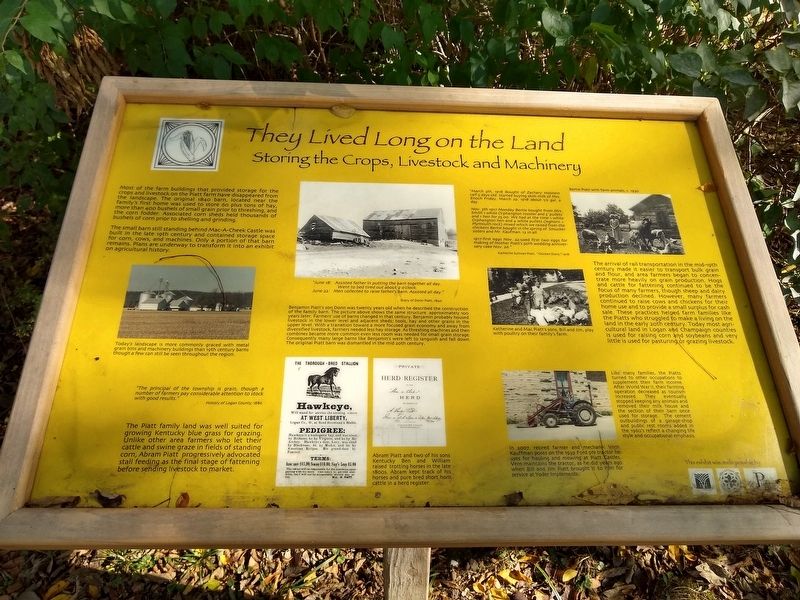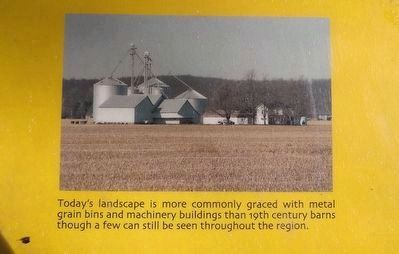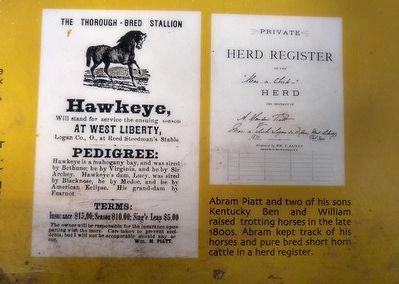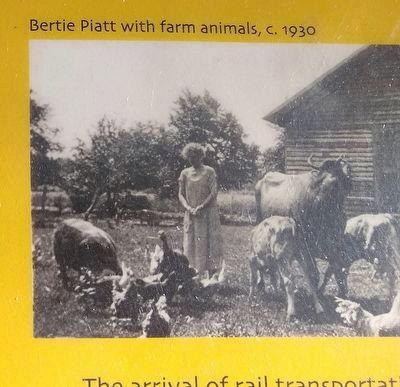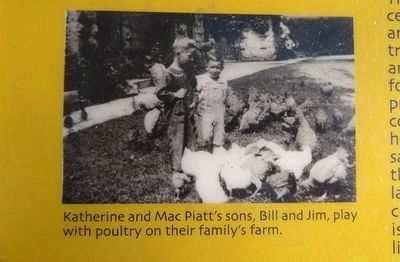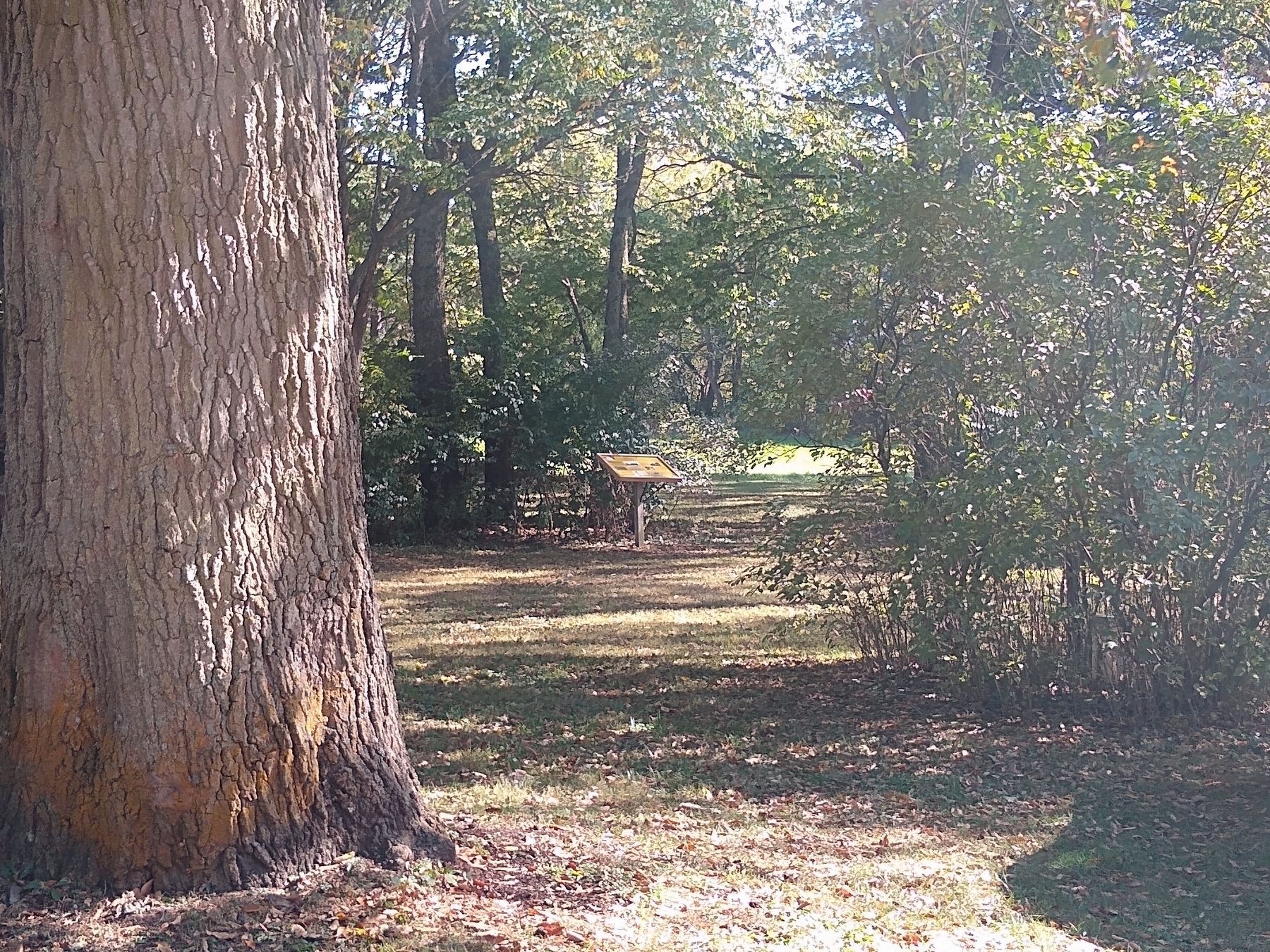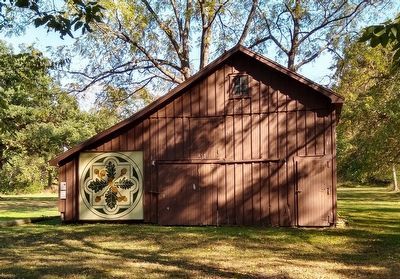Near West Liberty in Logan County, Ohio — The American Midwest (Great Lakes)
Storing the Crops, Livestock and Machinery
They Lived Long on the Land
Most of the farm buildings that provided storage for the crops and livestock on the Piatt farm have disappeared from the landscape. The original 1840 barn, located near the family's first home was used to store 60 plus tons of hay, more than 400 bushels of small grain prior to threshing, and the corn fodder. Associated corn sheds held thousands of bushels of corn prior to shelling and grinding.
The small barn still standing behind Mac-A-Cheek Castle was built in the late 19th century and contained storage space for corn, cows, and machines. Only a portion of that barn remains. Plans are underway to transform it into an exhibit on agricultural history.
"The principal of the township is grain, though a number of farmers pay considerable attention to stock with good results."
History of Logan County, 1880
The Piatt family land was well suite for growing Kentucky blue grass for grazing. Unlike other area farmers who let their cattle and swine graze in fields of standing corn, Abram Piatt progressively advocated stall feeding as the final stage of fattening before sending livestock to market.
"March 5th, 1918 Bought of Zachary Holstein calf 5 days old. Started buying skim milk of Mrs. Enoch Friday March 29, 1918 about 1/2 gal. a day.
Nov. 5th 1917 Monday Bertie bought from Mrs. Smith 1 with Orphangton rooster and 5 "pullets" and 1 hen for $5.00. We had at the time 1 white Orphangton hen and 4 white pullets (leghorn + Plymouth rock) mixed which we raised from the chickens Bertie bought in the spring of Smucker sisters and Mr. Kaufman, 12 in all.
1917-first eggs Nov. 22-used first two eggs for making of mother Piatt's 50th wedding anniversary cake Nov. 26."
Katherine Sullivan Piatt, "Chicken Diary," 1918
The arrival of rail transportation in the mid-19th century made it easier to transport bulk grain and flour, and area farmers began to concentrate more heavily on grain production. Hogs and cattle for fattening continued to be the focus of many farmers, though sheep and dairy production declined. However, many farmers continued to raise cows and chickens for their home use and to provide a small surplus for cash sale. These practices helped farm families like the Piatts who struggled to make a living on the land in the early 20th century. Today most agricultural land in Logan and Champaign counties is used for raising corn and soybeans and very little is used for pasturing or grazing livestock.
Like many families, the Piatts turned to other occupations to supplement their farm income. After World War II, their farming operation decreased as tourism increased. They eventually stopped keeping any animals
and removed the milk house and the section of their barn once used for storage. The cement outbuildings of a garage-shop and public rest rooms added in the 1960's reflect a changing life style and occupational emphasis.
Erected by Ohio Humanities Council, The Mac-A-Cheek Foundation for the Humanities, Piatt Castles.
Topics. This historical marker is listed in this topic list: Agriculture. A significant historical date for this entry is March 29, 1918.
Location. 40° 15.053′ N, 83° 43.587′ W. Marker is near West Liberty, Ohio, in Logan County. Marker can be reached from Township Road 47, 0.1 miles south of Ohio Route 245. Marker is east of Mac-A-Cheek Castle, which is about 700 feet from Township Road 47. Touch for map. Marker is at or near this postal address: 10051 Township Road 47, West Liberty OH 43357, United States of America. Touch for directions.
Other nearby markers. At least 8 other markers are within walking distance of this marker. The Barn at Mac-A-Cheek Castle (here, next to this marker); Who's in the Dog House? (within shouting distance of this marker); Let's Play (within shouting distance of this marker); A Castle as a Farmhouse (within shouting distance of this marker); Over a Century of Tours (within shouting distance of this marker); From Generation to Generation (within shouting distance of this marker); The Broad and Fertile Acres
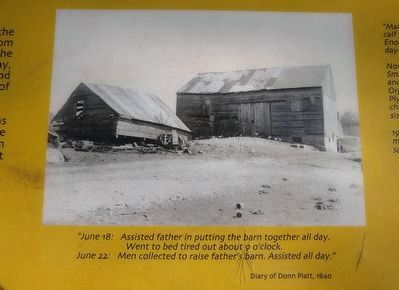
3. Storing the Crops, Livestock and Machinery Marker — upper middle image
"June 18: Assisted father in putting the barn together all day. Went to bed tired out about 9 o'clock.
June 22: Men collected to raise father's barn. Assisted all day."
Diary of Donn Piatt, 1840
Benjamin Piatt's son Donn was twenty years old when he described the construction of the family barn. The picture above shows the same structure approximately 100 years later. Farmers' use of barns changed in that century. Benjamin probably housed livestock in the lower level and adjacent sheds; tools, hay and other grains in the upper level. With a transition toward a more focused grain economy and away from diversified livestock, farmers needed less hay storage. As threshing machines and then combines became more common even less room was needed for small grain storage. Consequently many large barns like Benjamin's were left to languish and fall down.
June 22: Men collected to raise father's barn. Assisted all day."
Diary of Donn Piatt, 1840
Benjamin Piatt's son Donn was twenty years old when he described the construction of the family barn. The picture above shows the same structure approximately 100 years later. Farmers' use of barns changed in that century. Benjamin probably housed livestock in the lower level and adjacent sheds; tools, hay and other grains in the upper level. With a transition toward a more focused grain economy and away from diversified livestock, farmers needed less hay storage. As threshing machines and then combines became more common even less room was needed for small grain storage. Consequently many large barns like Benjamin's were left to languish and fall down.
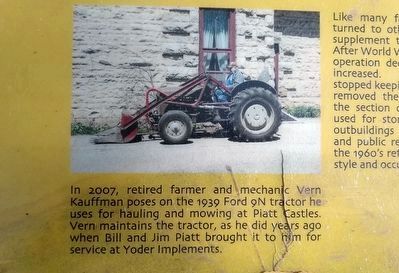
7. Storing the Crops, Livestock and Machinery Marker — lower right image
In 2007, retired farmer and mechanic Vern Kaufman poses on the 1939 Ford 9N tractor he uses for hauling and mowing at Piatt Castles. Vern maintains the tractor, as he did years ago when Bill and Jim Piatt brought it to him for service at Yoder Implements.
Credits. This page was last revised on January 27, 2020. It was originally submitted on January 27, 2020, by Joel Seewald of Madison Heights, Michigan. This page has been viewed 168 times since then and 8 times this year. Photos: 1, 2, 3, 4, 5, 6, 7, 8, 9. submitted on January 27, 2020, by Joel Seewald of Madison Heights, Michigan.
